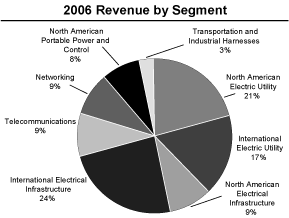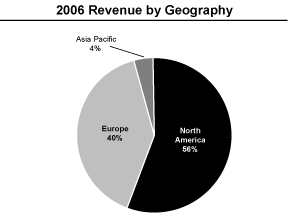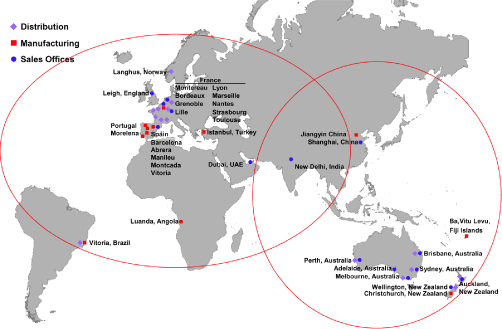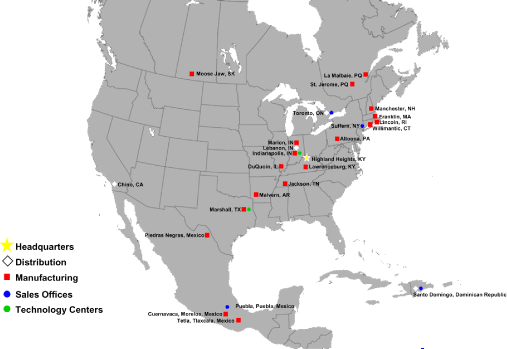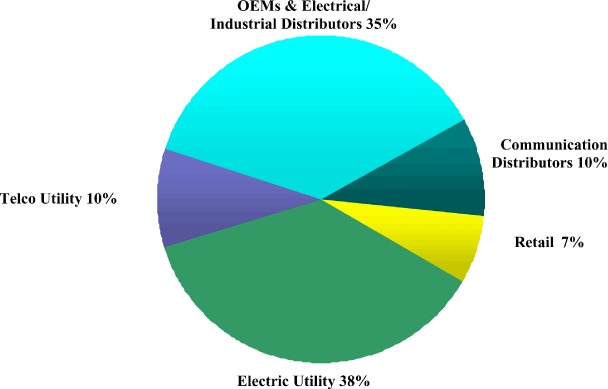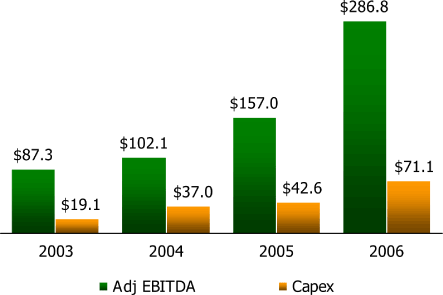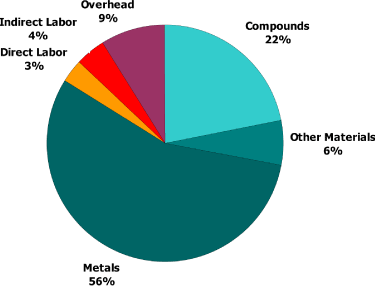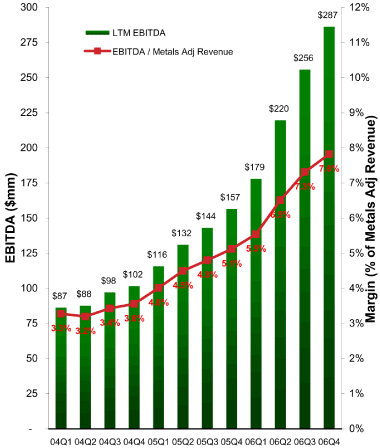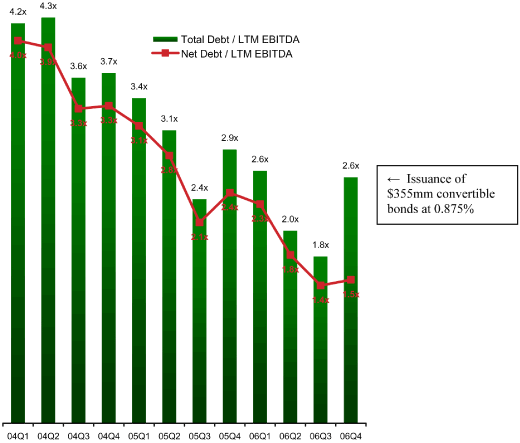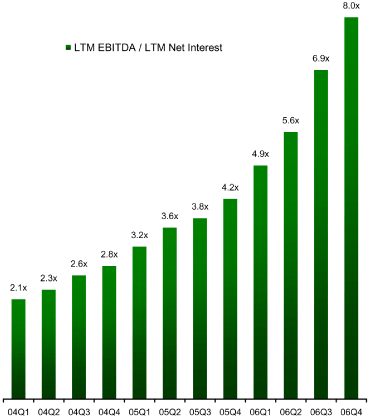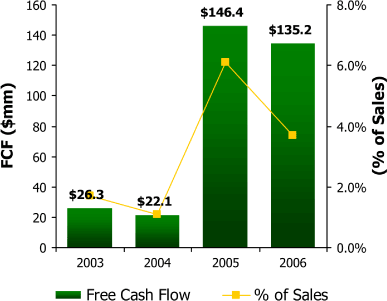Industry Overview and Trends
The global wire and cable market was estimated to have had $140 billion in sales in 2006 by CRU. In terms of volume, total metallic wire and cable grew at a compound annual growth rate of 4.7% from 2003 to 2006. This growth has been driven by demand for energy-related and networking cables. The energy-related cable sectors continue to benefit from increased spending by utilities in the developed world, where aging networks need to be upgraded and expanded, and investment in expanding infrastructure in the developing world. CRU estimates global wire and cable consumption will grow at an average annual rate of 3.3% through 2010. Key drivers of future growth in the wire and cable market include energy-related legislation and increased spending on infrastructure development.
Energy-Infrastructure Legislation. The 2003 power outages in North America and Europe and recently published studies, including a study released by the North American Electric Reliability Council, suggest that upgrades to the power transmission infrastructure in North America and Europe are necessary due to insufficient maintenance and upgrades in the past. In 2005, the United States passed legislation aimed at increasing the reliability and capacity of the transmission grid. We believe this legislation has increased demand for many of our products, in particular, our bare aluminum transmission cable. Furthermore, we believe the lack of historical investment and current industry fundamentals will support increased levels of infrastructure spending in the years to come. The International Energy Agency estimates that $1.7 trillion of investment is needed for new energy production, transmission and distribution in the United States and Canada over the next 30 years.
Higher Commodity Prices Driving Infrastructure Spending. Higher oil, base metal and other commodity prices are driving increased infrastructure spending, particularly among mining, petro-chemical and oil and gas companies, which are investing heavily in new capital projects to increase capacity and meet rising demand. This is driving increased sales of our North American and International Electrical Infrastructure products used in each of these markets.
Alternative Energy Legislation. In 2004, the United States passed legislation which provided for the renewal of tax credits for power generation from wind. We have been working with wind farm contractors, developers and wind turbine manufacturers on key wind farm projects in the United States, Canada, Italy, Portugal and New Zealand and believe we are well positioned to benefit from increased activity in this area.
Environmentally-Friendly Legislation in Europe. Tougher environmental requirements and a strong real estate market in Europe have led to increased demand for our low-smoke, zero-halogen residential construction cables.
The wire and cable industry is competitive, mature and cost driven. Wire and cable is relatively low value-added, higher weight (and therefore relatively expensive to transport) and often subject to regional or country specifications. We compete against a number of public and privately-held wire and cable companies in each of the geographic markets and product segments we serve. In many business segments there is little differentiation among participants from a manufacturing standpoint. Although the primary competitive factors vary somewhat across the different product categories, we believe the principal factors influencing competition are price, inventory availability, delivery time, breadth of product line, quality and customer service. The industry is highly fragmented with many participants in both the United States and worldwide; however, the industry has been undergoing consolidation in recent years.
The wire and cable industry is raw materials intensive with copper and aluminum comprising the major cost component for cable products. Changes in the cost of copper and aluminum are generally passed through to the customer, although there can be timing delays of varying lengths depending on the type of product, competitive conditions and particular customer arrangements.
Our Competitive Strengths
Global Competitor with World Class Scale. We have achieved leading market positions in many of our business segments. With 30 production facilities located throughout North America, Europe and Asia Pacific, we are able to provide local service to customers around the globe.
Broad Product Portfolio and Customer Diversity. We believe our product and customer diversity mitigates risks and creates sales opportunities. We sell our products under many well-established brands and we believe we have the most diversified product line of any United States wire and cable manufacturer. Our product breadth gives us the opportunity to expand our customer relationships by selling new items to existing customers. Our customers are leaders in their industries, with attractive growth prospects and favorable product mix requirements. Our products are sold through a variety of channels including electrical distributors, OEMs, and retailers in North America, Europe and Asia Pacific across a variety of markets. No single customer accounted for more than 5% of our sales in 2006.
Long Term Customer Relationships. We have developed long standing relationships and contracts with many of our customers by providing superior customer service and leveraging our extensive product portfolio. Historically, approximately 70% of our North American Electric Utility business revenues have been under contract prior to the start of each year. Also, approximately 80% of our Telecommunications sales are from customers under long term supply arrangements. Other long term relationships are held with various retail and OEM customers and distribution partners. Many of these arrangements include provisions allowing us to mitigate the effect of volatile raw material prices. As a result, we have been able to maintain stable levels of profitability over time.
Mitigate Volatile Raw Material Costs. Commodity costs generally comprise a significant portion of total costs and can impact profitability. We mitigate our exposure to commodity prices through contractual pass-through clauses, forward buying on firm purchase orders and frequent pricing updates. Through these initiatives, we believe that a significant amount of our revenue is hedged against commodity fluctuations.
Well Capitalized Balance Sheet. We generate consistent cash flows through a disciplined approach to growing sales while managing costs, capital expenditures and working capital. As a result, we have produced strong free cash flow as well as increased sales and EBITDA in each year since 2004. We have successfully reduced leverage from 3.3x Net Debt to Adjusted EBITDA at December 31, 2004 to 1.5x, as of December 31, 2006.
Experienced Management Team with Proven Track Record. Our senior management team has, on average, over 15 years of experience in the wire and cable industry with us. With strict operating discipline, we have demonstrated our ability to improve productivity, maintain customer relationships and generate cash flow through both industry and economic cycles. Additionally, our management team has successfully integrated four strategic acquisitions since 2005.
Our Business Strategies
Deliver Value-Added Products. Our ability to develop and deliver value-added products, such as transmission and distribution energy cables, turn-key high voltage systems, complex assemblies, specialty cables for oil, gas and petrochemical applications, low smoke-zero halogen products and high-bandwidth data cable designs, is a key driver of our growth in revenue and margins.
Strengthen and Expand Customer Relationships. Our success in the industry is largely based on our long standing relationships with our customers and our reputation for dependable service. On average, we have had relationships with each of our top 20 customers for at least 10 years. We focus on being the “wire and cable provider of choice” for the most demanding customers by providing a diverse product line coupled with a high level of service. Additionally, we provide technical resources to solve complex customer issues and maintain inventory levels of critical products that are sufficient to meet fluctuating demands.
Continue to Increase Cash Flow. We strive to leverage our operating systems, logistical expertise, and Lean manufacturing tools and techniques to increase margins and cash flow from operations. Driven by our Lean manufacturing programs we continue to reduce production costs through enhanced manufacturing processes and improved operating efficiencies that enhance our cash flow profile by reducing waste and minimizing investment in working capital. In 2006, our North American operations generated productivity improvements through Lean initiatives, including scrap savings, material usage reductions and reduction of labor related costs. In addition, we have implemented training and monitoring systems and procedures to maintain a safe, productive work environment, which leads to reduced costs associated with employee absences. We believe our successful implementation of these measures, and the resulting positive impact on cash flows, will continue to increase both the credit statistics and overall value of our business.
Pursue Strategic Growth Opportunities. We intend to continue making selective acquisitions in our core product areas that strengthen our operations, enhance our economies of scale and increase our geographic diversity. Our acquisition strategy is primarily focused on Electric Utility, Electrical Infrastructure and niche industrial businesses where we believe long term trends are favorable. Since March 2005, we have successfully completed five acquisitions, which we believe enhance our presence in targeted growth markets and strengthen our existing market share.
E-2
